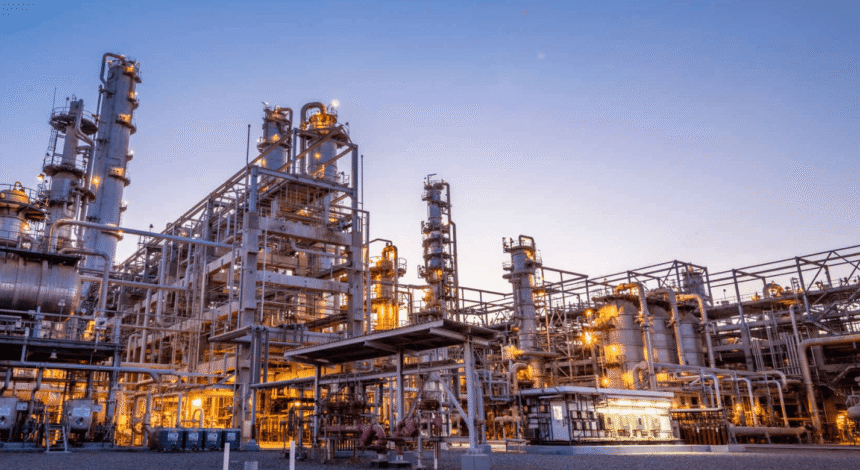Saudi Arabia has a bold vision to diversify its economy and reduce its dependence on oil revenue. Attracting foreign direct investment to industry will be crucial to this endeavor.
In Vision 2030, Saudi Arabia sets out a bold vision to diversify its economy and reduce its dependence on oil revenue. Attracting foreign direct investment (FDI) in the industrial sector will be crucial to this endeavor, as it helps drive economic growth, create jobs, grow knowledge of new technologies, and enhance competitiveness. In line with this, the Saudi Arabian government unveiled its National Investment Strategy in 2021 with ambitious aims to increase FDI in Saudi Arabia twenty-fold by 2030. To achieve this, the kingdom has already taken significant steps to enhance the investment climate in the country. In the FDI Confidence Index 2023, it is ranked 6th among emerging economies, which is a testament to the success of recent efforts (see figure 1).

Saudi Arabia has also embarked on a series of transformative projects as part of its long-term vision to create a sustainable future, including the construction of Neom, a futuristic megacity that will integrate cutting-edge technology and foster innovation. Within Neom, a 170-kilometer linear city known as The Line has been designed to have no streets, no cars, and no carbon emissions. The partially floating port city of Oxagon will not only revolutionize the way cities are built but also the way industrial manufacturing and logistics operate. At the same time, the Red Sea Development Company is building luxurious tourism destinations along the pristine Red Sea coast, where an entertainment megaproject in Qiddiya is set to create the region’s premier leisure and cultural hub. The Saudi Arabian government is also seeking to double Riyadh city’s population.
These major projects significantly increase industrial sector product demand in the kingdom and increase the need for industrial FDI.
Some steps have already been taken. Between 2011 and 2021, Saudi Arabia experienced a remarkable surge in FDI, from $5 billion to $19 billion. Additionally, it achieved a significant jump in its ranking in the Economic Complexity Index (ECI), moving from 99th to 42nd globally. It also grew its manufacturing sector—from representing $67 billion in GDP in 2011 to $109 billion in 2021.
To provide special incentives to attract foreign investment, Saudi Arabia has developed four new special economic zones (SEZs) in Riyadh, King Abdullah Economic City, Jazan, and Ras Al-Khair.
Importantly for those considering investing in the country, Saudi Arabia is increasingly requiring international companies to maintain a regional headquarters within the kingdom. By 2024, it is expected to introduce further measures along these lines.
Successful drivers for attracting industrial foreign direct investment
Developed markets such as the United States and Canada have had a longstanding track record of attracting FDI in the industrial sector. However, in the past decade developing markets have shown significant industrial growth—and FDI has been a key driver of that growth. Several factors in Singapore, India, South Korea, Mexico, Philippines, Vietnam, and Thailand have contributed to the increase in FDI in these nations. Saudi Arabia can draw important lessons from these countries’ approaches to further strengthen its position and become a global leader in attracting industrial FDI.
In this paper, three key metrics are used to measure the progress made by a country in attracting FDI: its FDI Confidence Index ranking, its ECI ranking, and its manufacturing value-added contributions to GDP.
Singapore was Asia’s second largest FDI recipient in 2021 (receiving around $100 billion). South Korea’s FDI inflows grew from around $10 billion in 2011 to $17 billion in 2021. Both countries ranked in the global top five for economic complexity, indicating high levels of diversification and sophistication in their economies.
In Southeast Asia, Vietnam and Thailand made significant strides toward attracting FDI and promoting industrial growth. Vietnam’s total FDI inflow doubled between 2011 and 2021. At the same time, the country’s manufacturing contribution to GDP skyrocketed from $32 billion in 2011 to $90 billion in 2021. Similarly, in the past 10 years, Thailand’s FDI has more than quadrupled—from $2.5 billion to $11.4 billion.
Mexico, the Philippines, and India also demonstrate remarkable progress. Mexico’s FDI inflows surged from $26 billion in 2011 to $32 billion in 2021. The Philippines’ ECI ranking jumped 16 places in 10 years. India’s FDI inflows surged from $36 billion to $45 billion over the same time frame, with the country now ranking seventh among FDI recipients globally. Its manufacturing GDP has increased from $294 billion in 2011 to an impressive $443 billion in 2021.
These countries all exhibit common factors that have enabled them to attract more investment, contributing significantly to their economic growth.
Success factor #1: Supporting investors on their investment journey
Benchmarked countries have strong frameworks in place that support the investor through their entire investment journey—from initial stages of strategy development, opportunity identification, and selection to advanced investment promotion and facilitation. These countries also support investors with deal closure and aftercare.
The Singapore Economic Development Board (EDB) is considered one of the best investor support systems globally. EDB acts as an industrial bank, providing loans to investors and thus playing a key role in attracting—and facilitating—investment into Singapore.
Figure 2 illustrates key steps in the investment journey derived from our research into global approaches.

Success factor #2: Tracking metrics
Countries that successfully attract investments track both effort-based and outcome-based metrics to identify areas requiring improvement and develop targeted strategies to optimize their investment attraction activities (see figure 3).

Effort-based metrics such as client satisfaction and response time provide insights into the efficiency and effectiveness of investment support services. Most investment promotion agencies (IPAs) (>90 percent) implement customer relationship management systems to track their performance metrics in order to improve investor relations and streamline their investment processes.
Outcome-based metrics offer a comprehensive view of the broader economic impact of investment promotion efforts. These metrics enable countries to gauge the degree to which their efforts yield tangible outcomes, including total FDI, job generation,
enhanced exports, and wage increases.
Success factor #3: Establishing a global presence
National IPAs of the benchmarked countries have a presence in many countries, and they actively forge a wide range of international partnerships (see figure 4).

Benchmarked countries have established offices abroad to enhance their global reach and to effectively engage with potential investors. For instance, KOTRA, a South Korean IPA, operates 127 offices in 86 countries. The Thailand Board of Investment has 14 overseas offices, while the Singapore Economic Development Board has 20. ProMexico had 46 trade and investment offices abroad—these were merged with the Ministry of
Economy in 2019, shifting the IPA’s international activities to Mexican embassies.
In addition to establishing international presence, most benchmarked countries have partnerships with other in-country and international IPAs, international chambers of commerce, and SEZ. Some countries, such as Mexico, have even mandated their embassies and consulates to take part in investor-attraction activities, integrating investment promotion efforts into their diplomatic missions.
Incorporating these best practices has significantly enhanced FDI inflows to these countries.
Success factor #4: Providing economic incentives
All benchmarked countries also offer corporate income tax reduction or exemptions and fixed asset import incentives such as duty-free imports for essential assets (for example, machinery and equipment, and raw materials) to boost investment and facilitate long-term growth.
By offering a 15-year corporate income tax exemption for establishing regional headquarters within the country, Thailand was able to attract the regional headquarters of 2,043 foreign companies as of 2020. Thailand not only benefits from the increased foreign direct investment associated with this, but also gains access to advanced technology, expertise, and global networks.
Another powerful incentive that has had a considerable impact among the benchmarked countries is the introduction of tax deductions on expenses related to research and development (R&D), technology, and knowledge transfer. These deductions have significantly enhanced the industrial sectors of some countries. R&D tax credits in Singapore and South Korea, for instance, can reach up to 40 percent, reflecting a strong governmental commitment to supporting cutting-edge advances and technological breakthroughs.
Incentive programs targeting specific sectors have also been impactful. Mexico implemented the Sectoral Promotion Program, reducing import duties by as much as 10 percent on raw materials and machinery for 23 industries, including electronics, agricultural machinery, automotive, and auto parts. The Philippines has adopted a similar approach through its Investment Priority Plan, offering incentives to industries that align with the nation’s development objectives.
India has taken a distinctive approach through the Production Linked Incentive (PLI) scheme. The PLI scheme is designed to reward companies based on their incremental production and investment in targeted sectors, encouraging domestic manufacturing. This innovative incentive structure has proven to be highly effective in attracting businesses, as it focuses on bolstering production capacities and fostering self-reliance within the nation.
Smartphone and electronic manufacturing have featured heavily in recent international investments in India by companies such as:
- Foxconn—$1 billion (iPhone manufacturing)
- Samsung—$650 million (smartphone manufacturing)
- Intel—$250 million (electronics manufacturing, and the establishment of a design and engineering center)
- Wistron—$180 million (smartphone and other electronic device manufacturing)
- Pegatron—$150 million (smartphone and other electronic device manufacturing)
However, other industries as diverse as energy and pharmaceuticals are also represented by companies such as:
- Hetero—$400 million (pharmaceutical ingredients manufacturing)
- Schneider Electric—$270 million (low-voltage switchgear manufacturing)
- GE—$200 million (wind turbine manufacturing)
- Siemens—$180 million (automation products manufacturing)
- Laurus Labs—$135 million (pharmaceutical ingredients manufacturing)
Vietnam, Thailand, and Mexico offer incentives based on a project’s geographic location to foster balanced regional development and address socioeconomic disparities. They provide up to 100 percent exemption on land rent and corporate income tax for projects situated in select geographic regions to stimulate growth in targeted regions. Additionally, projects that employ workers in rural areas are also eligible for these significant incentives.
The Philippines and Vietnam offer incentives across the value chain of targeted sectors rather than just to final producers. These incentives support all stages of production, from raw materials to the final product, boosting industrial productivity in both countries.
Singapore has implemented two innovative grant programs, the Enterprise Development Grant (EDG) and Resource Efficiency Grant for Energy (REG(E)). The EDG covers up to 80 percent of project costs for revamping business models or expanding into international markets and has supported more than 13,000 projects and disbursed more than $2.5 billion in grant funding. REG(E) is a non-tax incentive scheme that provides co-funding of up to 50 percent of qualifying costs to increase energy efficiency and reduce carbon emissions. Between 2010 and 2021, the scheme has seen $225 million invested in clean energy projects.
Figure 5 summarizes approaches to economic incentives across benchmarked countries in this report.

Six initiatives to boost industrial FDI
Drawing lessons from the benchmarked countries, these six initiatives have the potential to propel Saudi Arabia toward becoming a global frontrunner in attracting industrial FDI (see figure 6).

1. Demand visibility and guarantees
Enable state-owned enterprises to forecast demand and communicate it to the private sector. Transparent demand planning will increase investor confidence in investment opportunities and increase the flow of investment into the country.
Establish offtake agreements between the investor and state-owned enterprises to effectively guarantee demand for locally produced products. The demand locked in under an agreement will be a set percentage of the relevant state-owned enterprise’s expected demand.
Governments globally have used offtake agreements to promote investment in several sectors, but particularly in renewable energy. Atlas Renewable Energy has secured a 15-year power purchase agreement from the Mexican government to build a 3,000 MW solar power plant. Similarly, US-based Solar Reserve secured a 20-year power purchase agreement in South Africa to build a 100 MW plant, Pacific Gas and Electric signed a power purchase agreement in the United States, and the Indian government has signed a 25-year power purchase agreement to build a 750 MW solar power plant.
2. Supply chain development
Support SME development by creating local incubators to provide financial assistance and brand guidance for entrepreneurs.
Support SMEs to win more work locally by providing them with assistance to tender to state-owned enterprises. Create online presence for SMEs to sell their products in local and regional markets, and promote “Made in Saudi” products globally.
In Saudi Arabia, micro, small, and medium-sized enterprises (MSMEs) are still in their infancy, accounting for around 20 percent of industrial FDI. To spur increased industrial FDI, more investment in MSMEs may be needed.
One way to do so would be for Saudi Arabia to enhance its Kafalah program by offering larger loans and digitizing the SME banking system to maximize the program’s impact.
Currently, the Saudi Arabian government provides loans of up to $4 million to SMEs. In contrast, Malaysia provides loans up to $12 million, and Türkiye up to $20 million.
The Micro Units Development and Refinancing Agency (MUDRA) Bank in India supports microfinance institutions to provide low-interest loans to MSMEs. It is an example of how digital banking can be used to increase the number of MSMEs in a country. Between 2015 and 2022, it financed 408 million loans for beneficiaries that were worth a total of $280 billion.
3. Workforce development
Assess the 10-year pipeline for industrial activity to determine national educational requirements, including the provision of coursework and vocational training in cooperation with the private sector. Initiate upskilling and reskilling programs to address gaps.
Activate priority visa and path to citizenship for jobs that are deemed crucial to prioritized economic sectors.
4. Expansion of “Invest Saudi”
According to UNCTAD, the determinants of FDI include not only economic determinants (for example, market size, labor cost, and supply chain) but also investment promotion activities.
Increase global presence by establishing international offices. Currently, Invest Saudi has six offices, and it is far behind IPAs of globally best-in-class nations. South Korea, for instance, has at least 85 offices globally. Through such offices, Invest Saudi will be better able to engage with global investors and present the case for Saudi Arabia.
Collaborate with other national IPAs to promote FDI. Currently, the United Kingdom, United States, United Arab Emirates, China, and India are the top five sources of FDI into Saudi Arabia. It is prudent that Invest Saudi deepen ties with IPAs and chambers of commerce in these countries.
5. Elite investor experience
Create a world’s best investor journey. Revise and simplify business regulations to reduce bureaucracy and better align with internationally accepted approaches (for example, arbitration processes and bankruptcy laws). Review regulation modification and consultation mechanisms to ensure regulatory stability (for instance, avoid changes in VAT).
To better support investors, the Saudi Arabian government needs to provide different kinds of support at different stages of their investment journey, including:
- technical support during the opportunity identification and selection proces
- marketing and financial support during the investment promotion and facilitation process
- incentives, project management support, and regulatory and policy-related support during the deal closure process
- help in integrating local businesses and marketing, human resources, and advertising and public relations support, as part of the aftercare process
6. International partnerships
Set up international bilateral and multilateral trade agreements. Such agreements are generally mutually beneficial.
For example, FDI inflow to Mexico increased from $2.1 billion in 1993 to $28.3 billion in 2000, just six years after the North America Free Trade Agreement came into effect. Similarly, South Korea has been able to attract significant FDI from countries such as the United States, the European Union, and Japan since the implementation of its free trade agreements with those countries.
Pursue memberships in international bodies to assure quality systems in Saudi Arabia are on par with global standards. In this regard, progress has already been made, with the Saudi Accreditation Center working toward becoming a full member of internationally accepted accreditation bodies such as the International Accreditation Forum.
Full credit to Kearney for this analytical report published here.








